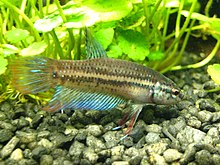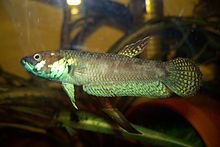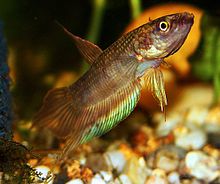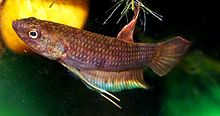Fighting fish
| Fighting fish | ||||||||||||
|---|---|---|---|---|---|---|---|---|---|---|---|---|

|
||||||||||||
| Systematics | ||||||||||||
|
||||||||||||
| Scientific name | ||||||||||||
| Betta | ||||||||||||
| Bleeker , 1850 |
The fighting fish ( Betta ) represent a genus of small freshwater fish within the labyrinth fish (Anabantoidei), the largest species of which, Betta unimaculata , does not exceed a total length of 160 mm.
Like all labyrinth fish, the species of the Betta genus have a labyrinth organ for the absorption of atmospheric oxygen , which enables them to colonize extremely low-oxygen freshwater (e.g. in rice-growing areas in Southeast Asia). All species feed primarily on small aquatic insects and mollusks and take care of their brood .
Some fighting fish - especially the males - are characterized by a pronounced blaze of color and are therefore very popular as aquarium fish , especially since these species usually only have low demands on the keeping conditions and can therefore also be recommended to a beginner in the aquarium hobby.
To make it easier to get an overview of the species-rich genus, similar species are grouped into circles of shapes .
General information on the genus Betta
The fighting fish owe their common name to the Thai tradition of using males of some species ( Betta splendens , Betta imbellis , Betta smaragdina and hybrids thereof) for fish fights, which are still very popular today. In particular, the Siamese fighting fish ( Betta splendens ), naturally endowed with a high potential for aggression, was domesticated to maintain this tradition. The “by-product” of this domestication is the veil fight fish , which has established itself worldwide as an aquarium fish through targeted further breeding and which now has a large number of different cultivated forms of its kind; Experts distinguish the different breeds especially according to the shape and size of the caudal fin.
The scientific generic name Betta is derived from the Javanese term wader bettah or ikan bettah and was used by Bleeker in 1878 to describe Betta picta . In Thai they are also known as Trey Krem or Pla-kad.
In nature, the smaller types of fighting fish in particular do not reach old age because they are subject to natural threats such as predators , parasite infestations and diseases.
Distribution area
The genus is distributed over large parts of Southeast Asia and inhabits both standing and flowing freshwater biotopes of the most varied of water quality.
The distribution area of the fighting fish extends from the islands around Bali to Indonesia (including the islands of Sumatra , Borneo and Java ) across the Malay Peninsula to Laos , Vietnam , Myanmar , Thailand and Cambodia .
Systematics
The genus Betta was introduced in 1850 by the Dutch ichthyologist Pieter Bleeker . The type species is Betta trifasciata , today a synonym for Betta picta . Betta belongs to the family Osphronemidae and there to the subfamily Macropodusinae (large fins). The family Osphronemidae belongs to the order of the climbing fish-like (Anabantiformes).
Reproductive strategies

In the case of fighting fish, a distinction is made between two basic reproductive strategies : on the one hand, mouth brood care and, on the other hand, brood care in the foam nest . In both cases, the male is primarily responsible for brood care, while the females are only secondary to the rearing of the young and in some cases are responsible for defending the territory and the breeding male. Some species fight and drive away the female after oviposition and fertilization; especially for brood care with a foam nest. In this case, experienced aquarists put the female in another tank, on the one hand to protect it, on the other hand to prevent the rearing male from destroying his foam nest himself through too many stressful disturbances.
Brood care in the foam nest
The strategy of brood care in the foam nest is considered to be the more original reproduction strategy in the genus of fighting fish. This form of rearing young can be found mainly in species from stagnant waters. The characteristic foam nest is a structure of air bubbles, which are taken up by the male on the surface of the water, coated in the mouth with a special secretion and then put together in a suitable place (mostly under plants on the water surface, less often in caves) to form a loose nest. Depending on the species and the individual character of the male, the size of the nest can range from a few air bubbles to relatively large structures of several centimeters in diameter and height. The spawning process usually takes place directly under the completed nest, in which the male brings the fertilized eggs after each individual mating and watches over them until the young have hatched and are swimming freely (in most cases 3 - 5 days). Foam nest-building Betta species are mostly small (3 - 6 cm standard length , an exception here is the B.bellica circle of shapes) and relatively intense and vividly colored, many species also develop iridescent shine scales. Particularly during spawning time, some of these species are extremely aggressive towards other species.
Typical representatives of the foam nest building types are:
Mouth brood care
Mouthbrood care is generally regarded as an adaptation to life in bodies of water with surface currents, in which a foam nest would not find support. The male takes the fertilized eggs into his mouth after mating (a behavior called “spitting eggs” can often be observed, in which the female picks up the eggs after mating and spits them in front of the male's mouth) and thereby protects them until the young hatch and swim free. Mouthbrood care usually takes significantly longer than brood care in a foam nest (depending on the species, about 10 - 20 days). The mouthbrooders represent the significantly larger group in the genus Betta .
Typical representatives of the mouth-brooding species are:
Exceptions and transitional forms
As a transitional forms between foam nest-building and mouthbrooding Betta species are primarily from the example foerschi -Formenkreis. It was originally assumed that B. foerschi was a foam nest -building fighting fish, as body and head shape suggest it - on closer observation, however, it turned out that the species must be counted among the mouthbrooders, although there are many in spawning behavior Draw parallels to foam nest building species.
An exception among the foam nest-building species is a population of Betta brownorum from West Kalimantan . While all other known populations of B. brownorum build foam nests, this variant practices mouth brood care.
Types (in shape circles)
Akarensis shape circle
- Betta akarensis Regan, 1910
- Betta antonii Tan & Ng, 2006
- Betta aurigans Tam & Lim, 2004
- Betta balunga Herre, 1940
- Betta chini Ng, 1993
- Betta ibanorum Tan & Ng, 2004
- Betta pinguis Tan & Kottelat, 1998
- Betta obscura Tan & Ng, 2005
Albimarginata shape circle
- Betta albimarginata Kottelat & Ng, 1994
- Betta channoides Kottelat & Ng, 1994
Anabantoides shape circle
- Betta anabatoid Bleeker, 1851
Bellica shape circle
- Betta bellica Sauvage, 1884
- Betta simorum Tan & Ng, 1996

Coccina shape circle
- Betta brownorum Witte & Schmidt, 1992
- Betta burdigala Kottelat & Ng, 1994
- Betta coccina Vierke, 1979
- Betta hendra Schindler & Linke, 2013
- Betta livida Ng & Kottelat, 1992
- Betta miniopinna Tan & Tan, 1994
- Betta persephone Schaller, 1986
- Betta rutilans Witte & Kottelat, 1991
- Betta tussyae Schaller, 1985
- Betta uberis Tan & Ng, 2006
Dimidiata shape circle
- Betta dimidiata Roberts, 1989
- Betta krataios Tan & Ng, 2006
Edithae shape circle
- Betta edithae Vierke, 1984
Foerschi circle of shapes
- Betta dennisyongi Tan, 2013
- Betta foerschi Vierke, 1979
- Betta strohi Schaller & Kottelat, 1989
- Betta mandor Tan & Ng, 2006
- Betta rubra Perugia, 1893
Picta shape circle
- Betta falx Tan & Kottelat 1998
- Betta picta Valenciennes, 1846
- Betta trifasciata Bleeker, 1850
- Betta simplex Kottelat, 1994
- Betta taeniata Regan, 1910
Pugnax shape circle
- Betta apollon Schindler & Schmidt, 2006
- Betta breviobesus Tan & Kottelat, 1998
- Betta cracens Tan & Ng, 2005
- Betta enisae Kottelat, 1995
- Betta ferox Schindler & Schmidt, 2006
- Betta fusca Regan, 1910
- Betta lehi Tan & Ng, 2005
- Betta pallida Schindler & Schmidt, 2004
- Betta prima Kottelat, 1994
- Betta pugnax Cantor, 1849
- Betta pulchra Tan & Tan, 1996
- Betta schalleri Kottelat & Ng, 1994
- Betta stigmosa Tan & Ng, 2005
- Betta raja Tan & Ng, 2005

Splendens shape circle
- Betta imbellis Ladiges, 1975
- Betta mahachaiensis Kowasupat et al., 2012
- Betta siamorientalis Kowasupat et al., 2012
- Betta smaragdina Ladiges, 1972
- Betta splendens Regan, 1910
- Betta stiktos Tan & Ng, 2005

Unimaculata shape circle
- Betta compuncta Tan & Ng, 2006
- Betta gladiator Tan & Ng, 2005
- Betta ideii Tan & Ng, 2006
- Betta macrostoma Regan, 1910
- Betta ocellata de Beaufort, 1933
- Betta pallifina Tan & Ng, 2005
- Betta patoti Weber & de Beaufort, 1922
- Betta unimaculata Popta, 1905
Waseri circle of shapes
- Betta chloropharynx Kottelat & Ng, 1994
- Betta hipposideros Ng & Kottelat, 1994
- Betta omega Tan & Bin Ahmad, 2018
- Betta pi Tan, 1998
- Betta renata Tan, 1998
- Betta spilotogena Ng & Kottelat, 1994
- Betta tomi Ng & Kottelat, 1994
- Betta waseri Krummenacher, 1986
So far undescribed Betta species
- Betta sp. aff. albimarginata "Malinau"
- Betta sp. aff. pallifina "East Kalimantan"
- Betta sp. aff. emeraldina "Mahachai"
- Betta sp. aff. waseri "Anjungan"
- Betta sp. aff. waseri "Pekan Nanas"
- Betta sp. aff. waseri "Pekanbaru"
- Betta sp. cf. great "Bung Binh"
- Betta sp. "Bangka"
- Betta sp. "Jantur Gemeruh"
- Betta sp. "Karimata Island"
- Betta sp. "Ketapang"
- Betta sp. "Medas"
- Betta sp. "Sarawak, Semantan"
- Betta sp. "Sinkawang"
- Betta sp. "Southern Thailand"
- Betta sp. "Tayan"
literature
- R. Donoso-Büchner, Dr. J. Schmidt: fighting fish - wild forms . ISBN 3-933646-09-X .
- H. Pinter: Labyrinth fish, pike heads and snakehead fish . ISBN 3-8001-7093-0 .
Web links
Individual evidence
- ↑ R. Massilamoni & Dr. J. Schmidt: "Your hobby - veil fight fish", p. 9
- ↑ R. Donoso-Büchner & Dr. J. Schmidt: "Your hobby - fighting fish wild forms", p. 6
- ↑ Pieter Bleeker (1850): Bijdrage tot de kennis der Visschen met Doolhofvormige kieuwen van den Soenda-Molukschen archipelago. Negotiations of the Bataviaasch Genootschap van Kunsten en Wetenschappen. Volume 23 (No. 8)
- ↑ Lukas Rüber, Ralf Britz & Rafael Zardoya: Molecular Phylogenetics and Evolutionary Diversification of Labyrinth Fishes (Perciformes: Anabantoidei). Syst. Biol. 55 (3): 374-397, 2006 ISSN 1063-5157 doi: 10.1080 / 10635150500541664
- ↑ Ricardo Betancur-R, Edward O. Wiley, Gloria Arratia, Arturo Acero, Nicolas Bailly, Masaki Miya, Guillaume Lecointre and Guillermo Ortí: Phylogenetic classification of bony fishes . BMC Evolutionary Biology, BMC series - July 2017, DOI: 10.1186 / s12862-017-0958-3
- ^ Thomas J. Near, A. Dornburg, RI Eytan, BP Keck, WL Smith, KL Kuhn, JA Moore, SA Price, FT Burbrink, M. Friedman & PC Wainwright. 2013. Phylogeny and tempo of diversification in the superradiation of spiny-rayed fishes. Proceedings of the National Academy of Sciences of the United States of America. 101: 12738-21743. doi: 10.1073 / pnas.1304661110 , PDF
- ↑ R. Donoso-Büchner & Dr. J. Schmidt: "Your hobby - fighting fish wild forms", p. 8









